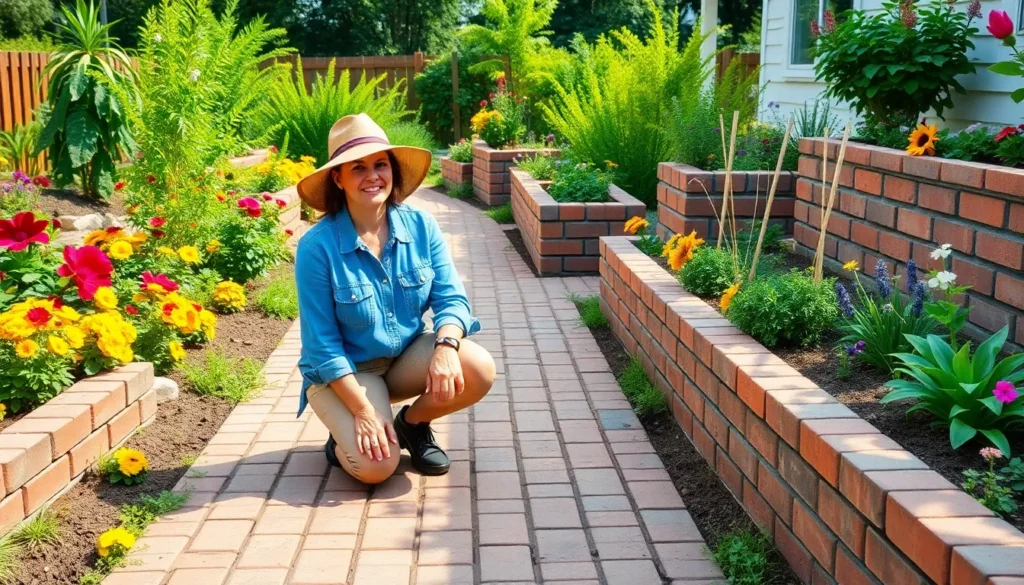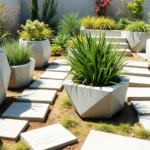We’ve all walked through stunning gardens and wondered how to recreate that timeless charm in our own outdoor spaces. Bricks offer the perfect solution – they’re durable, versatile, and add instant character to any industry design. Whether you’re working with a sprawling backyard or a cozy urban patio, brick garden features can transform your space from ordinary to extraordinary.
From classic brick pathways that guide visitors through your garden to raised planters that showcase your favorite blooms, the possibilities are endless. We’ll show you how to use reclaimed bricks for sustainable projects, create stunning focal points with brick edging, and even build functional features like fire pits and seating areas.
Ready to discover how this humble building material can elevate your garden game? Let’s explore creative brick garden ideas that’ll have your neighbors asking for design tips.
Create Stunning Brick Garden Pathways and Walkways
Brick pathways transform ordinary garden spaces into elegant outdoor corridors that guide visitors through your industry with timeless charm. These durable walkways offer both practical navigation and aesthetic appeal while complementing various architectural styles.
Herringbone Pattern Brick Paths
Herringbone brick patterns create sophisticated walkways that add visual interest through their distinctive zigzag design. This classic arrangement involves laying bricks at 90-degree angles to form interlocking V-shaped patterns that distribute weight evenly across the surface.
Installation begins with proper base preparation using 2-3 inches of sand over compacted gravel for optimal drainage. We recommend standard-sized bricks measuring 8 inches by 4 inches for authentic herringbone layouts that maintain consistent spacing throughout the pathway.
Pattern variations include straight and diagonal herringbone designs that suit different garden styles and traffic requirements. Straight herringbone patterns align parallel to pathway edges while diagonal versions create ever-changing movement that draws the eye forward along curved or straight routes.
Curved Brick Walkways for Natural Flow
Curved brick walkways blend seamlessly with organic garden landscapes by following natural contours and creating gentle transitions between different outdoor areas. These flowing paths encourage leisurely strolls while softening harsh geometric lines in structured garden designs.
Flexible edging materials like plastic or metal strips help maintain smooth curves during installation and prevent brick displacement over time. We suggest marking curved pathways with garden hoses or spray paint before excavation to visualize the final shape and make necessary adjustments.
Brick cutting becomes essential for tight radius curves where standard rectangular bricks create unwanted gaps or uneven surfaces. Half bricks and custom-cut pieces fill irregular spaces while maintaining consistent joint widths throughout curved sections.
Mixed Material Pathways with Brick Accents
Mixed material pathways combine bricks with complementary elements like natural stone, concrete pavers, or decorative gravel to create unique textural contrasts. These hybrid designs reduce brick costs while adding visual complexity that enhances overall garden aesthetics.
Brick borders frame gravel or mulched walking surfaces to provide defined edges and prevent loose materials from spreading into adjacent planting areas. Standard clay bricks set on edge create clean lines that separate pathway materials from surrounding industry elements.
Alternating brick and stone sections establish rhythm throughout longer walkways while accommodating different budget requirements and material availability. We recommend maintaining consistent width measurements across all material transitions to ensure smooth pedestrian flow and professional appearance.
Build Beautiful Brick Garden Borders and Edging
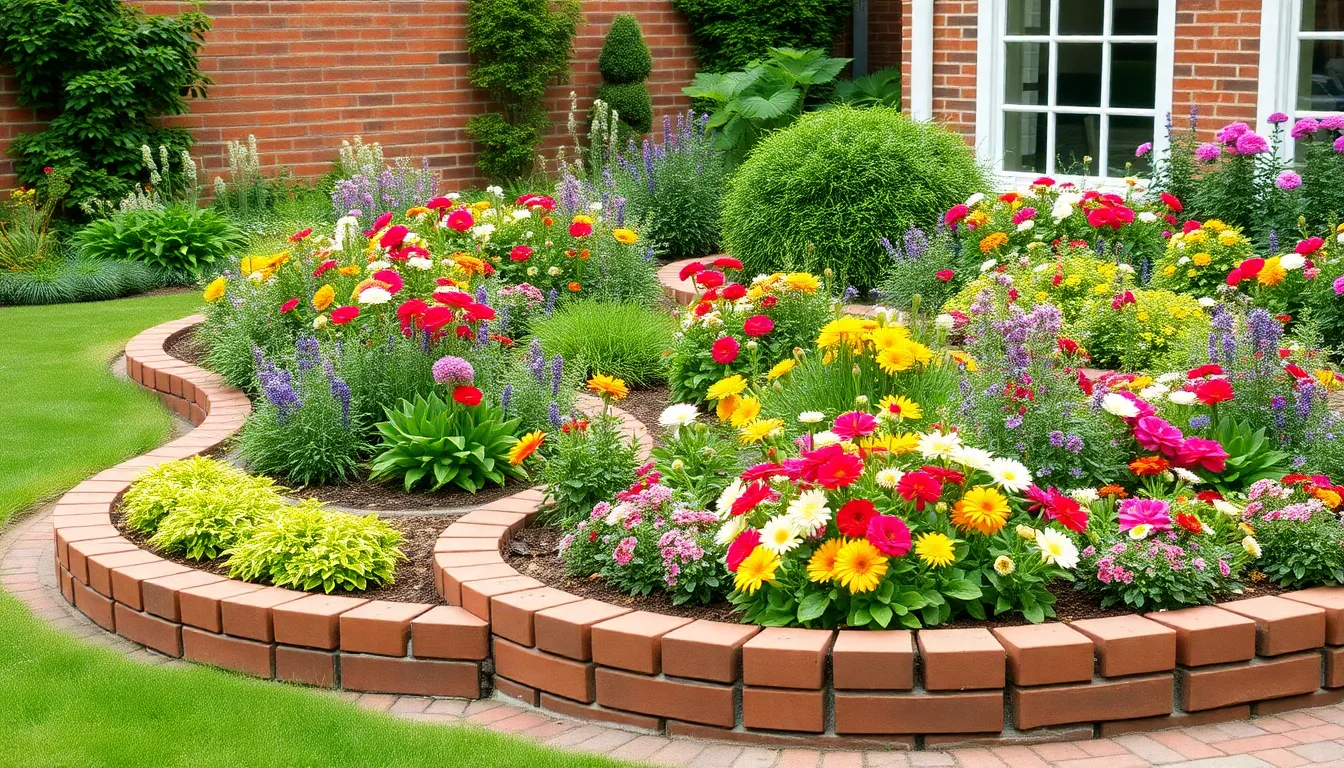
After creating stunning pathways, we can extend the brick design to define and enhance garden beds with attractive borders and edging answers.
Classic Straight Brick Borders
Straight brick borders deliver a timeless approach to defining garden beds and pathways. They create a clean traditional look that complements both classic and modern garden designs perfectly. Installation involves laying bricks in a straight line using mortar for a sturdy permanent finish. This style remains easy to maintain and suits gardens with formal layouts exceptionally well.
Benefits include clear separation between lawn and garden areas, reduced maintenance around plant beds, and enhanced visual structure. We recommend using standard clay bricks or recycled options to maintain consistency with existing hardscaping elements. The formal appearance works particularly well with geometric garden designs and structured landscaping approaches.
Curved Brick Edging for Flower Beds
Curved brick edging adds a softer more natural touch to flower beds throughout your garden space. It creates a flowing organic look that complements various plant arrangements beautifully. Installation requires laying bricks in curved patterns often without mortar to allow flexibility and adjustments over time.
This style proves ideal for gardens with lush wild plantings and naturalistic design themes. Curved edges help blend formal hardscaping with informal planting schemes seamlessly. We suggest marking the desired curve with spray paint before installation to ensure smooth consistent lines. The flexible nature allows for seasonal adjustments as plants grow and garden layouts evolve.
Raised Brick Garden Borders
Raised brick borders involve stacking bricks to create elevated edges around garden beds. This style provides additional structure and helps retain mulch or soil within designated growing areas effectively. Installation requires two or more layers of bricks stacked with slight overlaps using mortar for permanent structures or dry stacking for flexibility.
This design proves useful for gardens with multiple levels or areas requiring enhanced visual interest. Raised borders offer improved drainage control and make garden maintenance more comfortable by reducing bending. We recommend heights between 6 to 12 inches for optimal functionality without overwhelming plant displays. The elevated design also helps prevent soil erosion during heavy rainfall periods.
Design Functional Brick Raised Garden Beds
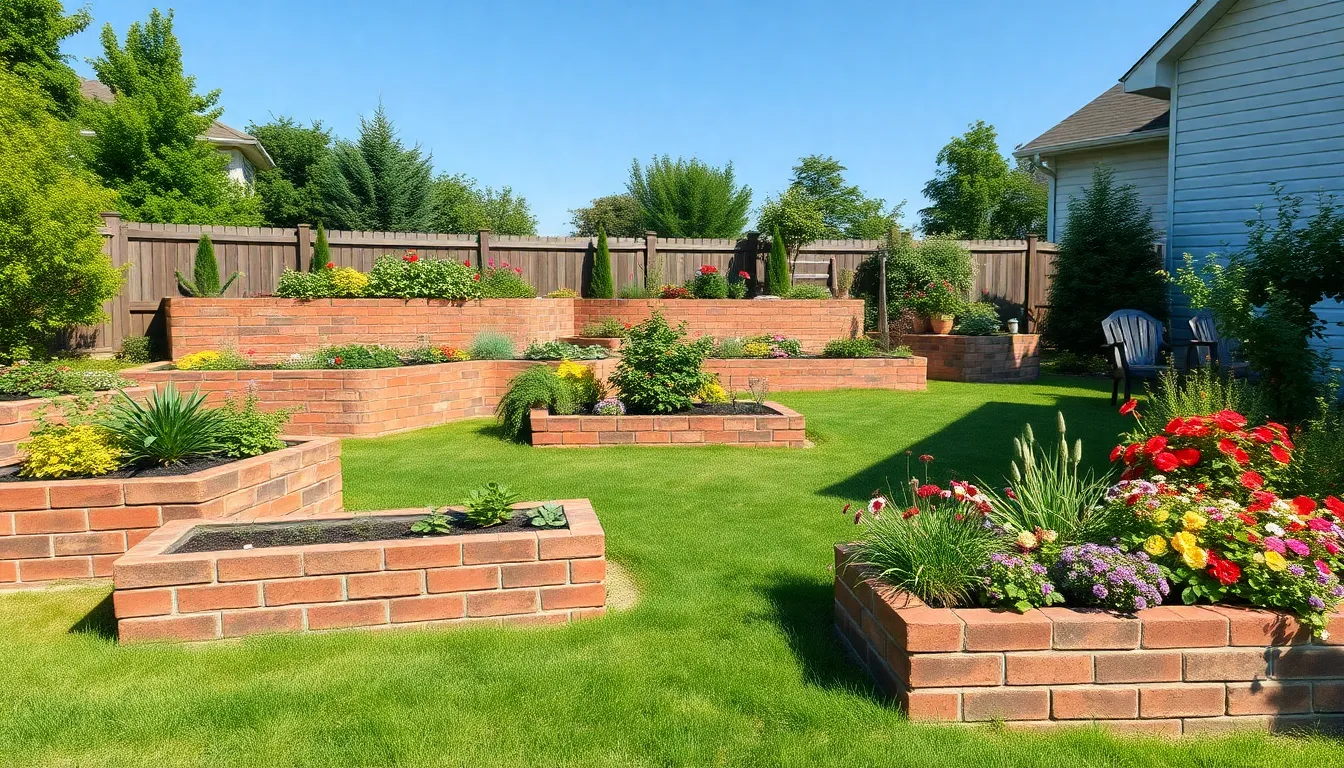
Raised garden beds offer excellent drainage while creating visually appealing growing spaces. We’ll explore three practical designs that work well for different garden situations and provide superior soil retention compared to traditional ground-level planting.
Traditional Rectangular Brick Planters
Rectangular planters deliver simplicity and versatility for any garden size. These structures accommodate vegetables, herbs, and flowers while maintaining clean lines that complement both formal and casual industry designs. We can paint the bricks to match our garden’s color scheme or leave them natural for a classic appearance.
Building these planters requires basic masonry skills and provides long-lasting results. The rectangular shape maximizes growing space while allowing easy access from all sides. Plants thrive in these containers because bricks naturally regulate soil temperature and moisture levels.
Tiered Brick Garden Beds for Slopes
Tiered beds transform challenging slope areas into productive growing spaces. Each level creates distinct planting zones that prevent soil erosion while adding dramatic visual interest to hillside gardens. We can dedicate different tiers to various plant types, creating natural separation between vegetables, herbs, and ornamental flowers.
Stabilization becomes crucial on sloped terrain, and bricks excel at holding soil in place during heavy rains. The stepped design allows water to move gradually from tier to tier rather than rushing downhill. Each level receives adequate drainage while maintaining proper moisture retention for healthy plant growth.
Corner Brick Raised Beds for Small Spaces
Corner beds maximize limited garden areas by utilizing often overlooked spaces. These custom-designed structures fit snugly into tight corners while providing substantial growing room for compact gardens. We can adjust the dimensions to match available space and create unique shapes that complement existing industry features.
Small space gardening benefits tremendously from vertical growing opportunities that corner beds provide. The triangular or L-shaped configurations offer surprising planting capacity while maintaining easy access for maintenance tasks. Bricks allow complete customization to fit any corner dimension or shape requirement.
Construct Decorative Brick Garden Walls and Screens
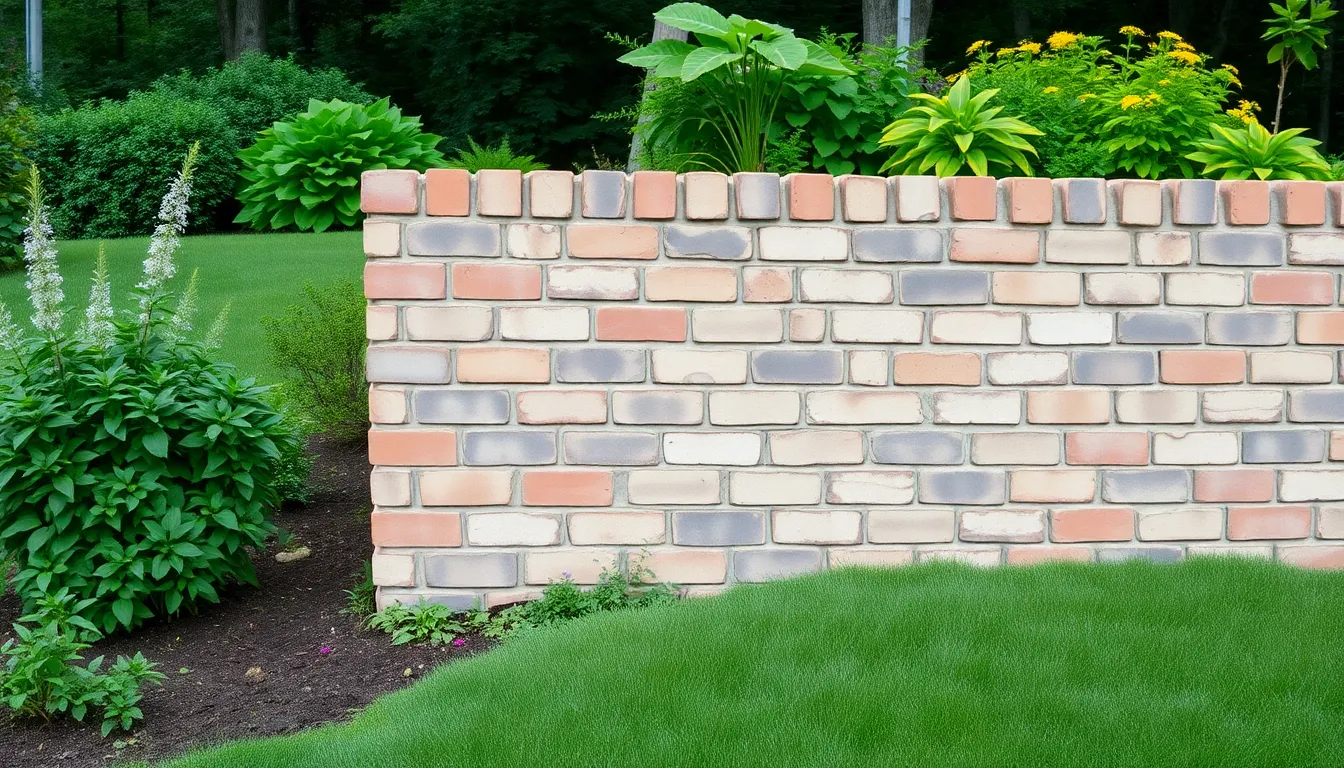
Building decorative brick walls and screens transforms ordinary gardens into structured outdoor sanctuaries. We’ll explore three essential wall designs that combine functionality with visual appeal.
Low Brick Retaining Walls
Low retaining walls solve sloped garden challenges while adding architectural interest to your industry. These structures provide essential support for hillside gardens and prevent costly soil erosion that can damage plants and property.
Design flexibility makes low brick walls perfect for any garden style. We can build simple single-course walls for gentle slopes or elaborate multi-tiered designs for steeper terrain. The natural drainage properties of brick construction help prevent water buildup behind the wall.
Installation requires proper foundation preparation and drainage considerations. We recommend digging below the frost line and adding gravel base layers for long-term stability. Mortar joints should include weep holes every few feet to allow water escape.
Height limitations typically keep these walls under 3 feet for DIY projects. Taller retaining walls need professional engineering and permits in most areas. The rustic charm of weathered bricks complements both formal and cottage garden designs.
Decorative Brick Privacy Screens
Privacy screens create intimate garden rooms while maintaining visual interest throughout your outdoor space. These versatile structures block unwanted views from neighboring properties without creating fortress-like barriers.
Pattern variations add personality to standard privacy walls. We can incorporate openwork designs using soldier courses, basket weave patterns, or decorative cutouts that filter light while maintaining privacy. These design elements prevent solid walls from appearing heavy or oppressive.
Strategic placement maximizes privacy benefits in targeted areas. Screens work perfectly around patios, hot tubs, or vegetable gardens where complete privacy is desired. Partial height screens maintain sight lines while creating psychological boundaries.
Construction techniques for privacy screens differ from solid walls. We often use reinforcing steel within the wall structure and deeper footings to handle wind loads. The open patterns in decorative screens actually help reduce wind pressure compared to solid barriers.
Curved Brick Garden Walls
Curved walls create ever-changing focal points that soften hard industry lines throughout garden spaces. These flowing structures add visual movement and can guide visitors along exact pathways or toward featured garden areas.
Integration opportunities abound with curved brick walls. We can incorporate built-in planters, water features, or seating areas that follow the wall’s natural curve. The flowing lines complement informal garden styles and naturalistic planting schemes.
Construction challenges require careful planning and specialized techniques. We use string lines attached to a central pivot point to maintain consistent curves during installation. Cutting bricks to follow the curve creates natural mortar joint variations that enhance the organic appearance.
Placement considerations affect the overall garden flow and functionality. Curved walls work exceptionally well as backdrop features for specimen plants or sculpture displays. They can also define separate garden rooms while maintaining visual connections between spaces.
Install Brick Patio and Seating Areas
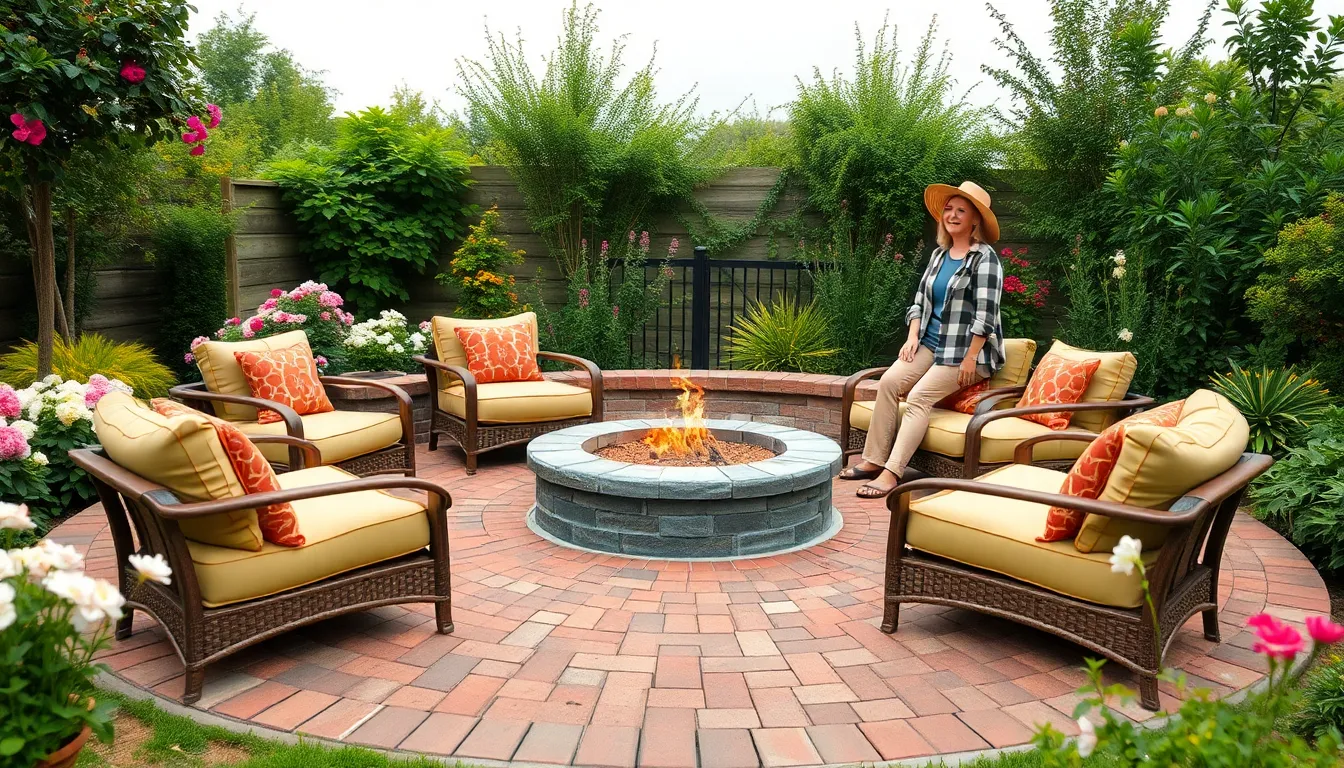
Creating functional outdoor living spaces through brick patios transforms our gardens into durable entertainment zones. Installing brick patios provides excellent durability and visual appeal while offering various pattern and color options to match our garden’s unique style.
Circular Brick Patio Designs
Circular brick patios create inviting gathering spaces that naturally promote social interaction in our outdoor areas. We can design these round spaces with central focal points like fire pits or decorative statues surrounded by comfortable seating arrangements. Building circular patterns requires careful planning to achieve smooth curves and proper brick alignment throughout the installation process.
Installing these unique patio designs creates cozy atmospheres that encourage conversations and community gatherings. We’ll find that circular layouts work exceptionally well in larger garden spaces where we want to establish distinct entertainment zones. Designing with radiating brick patterns from the center outward provides visual interest while maintaining structural integrity for long-term durability.
Brick Fire Pit Seating Areas
Fire pit seating areas built with bricks become popular gathering features that provide warmth and ambient lighting for evening entertainment. We can construct these areas using curved or square bench designs that create natural conversation circles around the central fire feature. Building permanent brick seating eliminates the need for movable outdoor furniture while ensuring weather-resistant durability.
Positioning brick benches at appropriate distances from fire pits ensures comfortable seating temperatures and safe entertaining environments. We should consider incorporating back supports and arm rests into our brick bench designs for enhanced comfort during extended gatherings. Installing these permanent features creates focal points that anchor our outdoor entertainment spaces while providing year-round functionality.
Built-in Brick Garden Benches
Built-in brick benches add permanent seating answers that blend seamlessly with our garden’s existing industry design. We can construct these features to serve dual purposes as seating areas and boundary markers between different garden zones. Building benches with proper height and depth ensures comfortable seating while maintaining visual harmony with surrounding plantings.
Designing these permanent fixtures provides timeless aesthetic appeal that requires minimal maintenance compared to wooden alternatives. We’ll discover that built-in brick benches create natural resting spots throughout our gardens while offering sturdy surfaces for placing gardening tools or decorative elements. Installing these features strategically helps define garden pathways and creates inviting spaces for contemplation and relaxation.
Add Brick Water Features to Your Garden
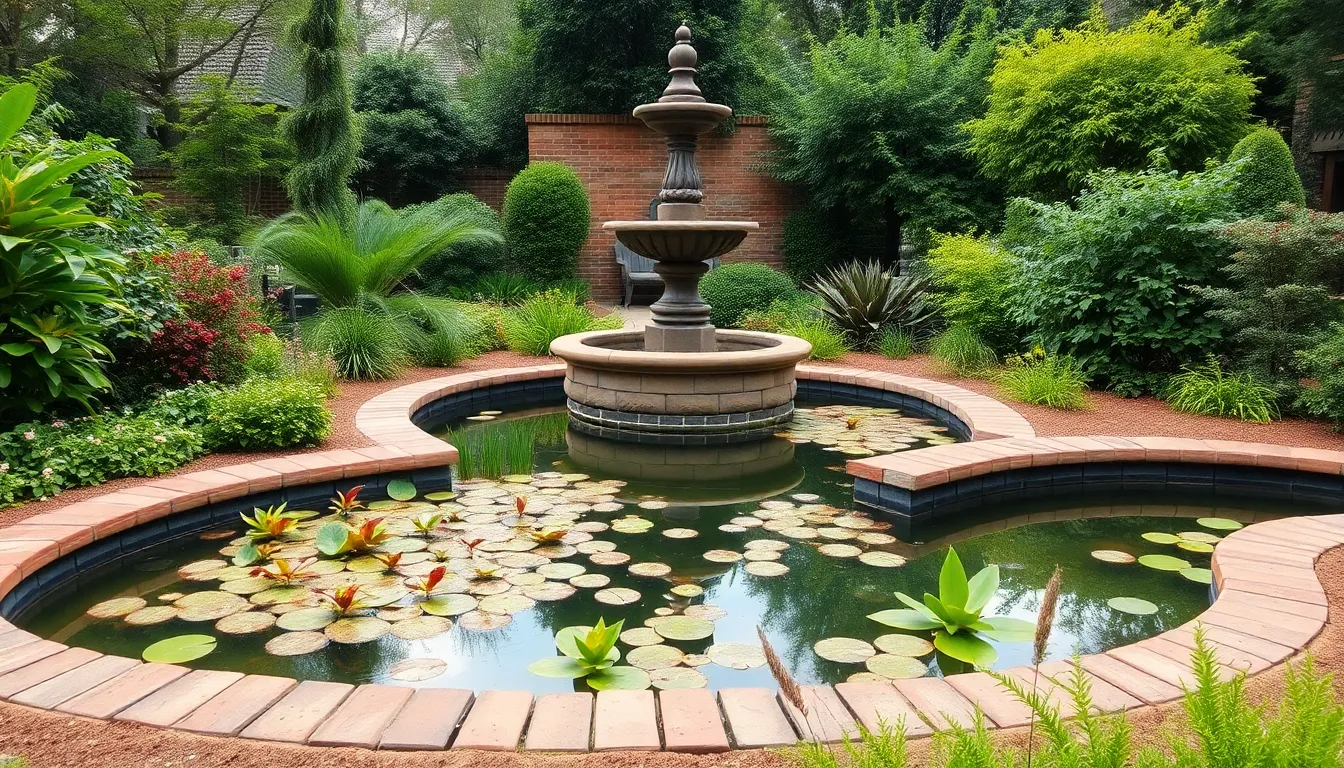
Water features bring tranquility and visual interest to garden spaces, and bricks provide the perfect material for constructing durable aquatic elements. Our experience shows that brick water features integrate seamlessly with existing garden landscapes while offering easy maintenance and customization options.
Brick-Lined Garden Ponds
Garden ponds lined with bricks create stable edges that prevent soil erosion and define clear water boundaries. We recommend laying bricks in decorative patterns like herringbone or basketweave to add visual interest around pond perimeters. The natural color of brick complements both foliage and aquatic plants, improving the overall pond appearance.
Installing brick pond lining requires proper preparation and leveling to ensure durability. We suggest using a concrete base beneath the bricks for added stability and longevity. Mortar joints between bricks should be sealed properly to prevent water leakage and maintain structural integrity.
Brick Fountain Bases and Surrounds
Fountain bases constructed from bricks ensure stability and weather resistance for years of enjoyment. We often layer bricks to form raised platforms or decorative borders around fountain structures, creating classic foundations that withstand frequent water exposure. Their modular design allows us to create flexible shapes and sizes that match existing garden features.
Building brick fountain surrounds requires careful attention to drainage and water flow patterns. We recommend incorporating weep holes in the base construction to prevent water accumulation and potential damage. The versatility of brick allows for both simple circular designs and complex geometric patterns that enhance fountain aesthetics.
Decorative Brick Water Channels
Water channels lined with bricks guide water flow throughout gardens while serving as functional drainage answers and ornamental elements. We design these channels to meander through planting beds or along walkways, adding movement and visual appeal to garden layouts. Channels paired with brick pathways or walls create cohesive design themes throughout outdoor spaces.
Constructing brick water channels requires proper grading and slope calculations to ensure efficient water movement. We install these features with slight inclines toward drainage points or collection areas. The durability of brick lining withstands weather conditions and water flow, making these channels both practical and beautiful garden additions.
Create Brick Garden Steps and Terracing
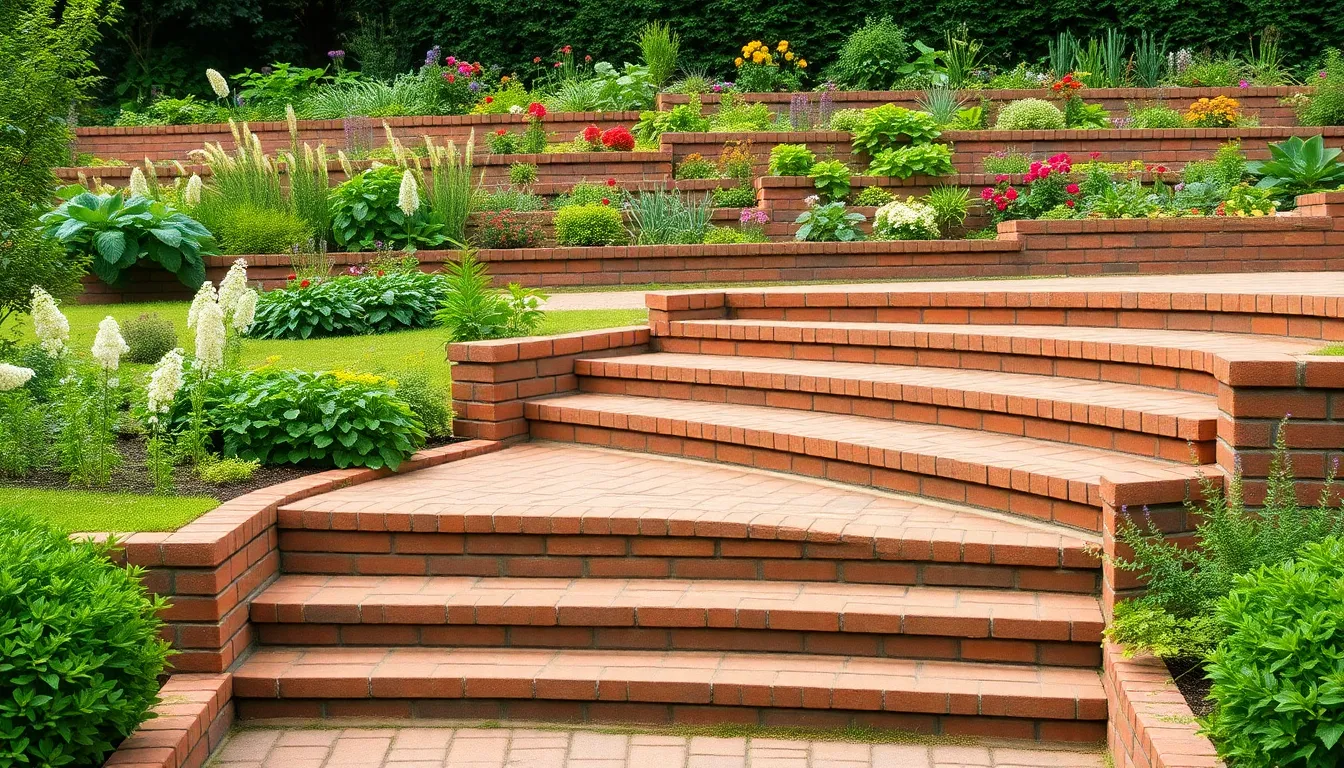
Building steps and terraces with bricks transforms challenging slopes into functional garden spaces while adding architectural elegance to your outdoor design.
Formal Brick Garden Steps
Formal brick steps create structured pathways that guide visitors through different garden areas with timeless sophistication. We recommend incorporating these elegant features to connect seating areas, vegetable patches, and other garden zones seamlessly. High quality bricks that resist weather damage ensure your steps maintain their beauty for years to come.
Design your formal steps with consistent proportions, using standard brick dimensions to create uniform risers and treads. Mortar mix provides the stability and longevity needed for heavy foot traffic areas. Consider adding brick borders along the sides to complete the formal appearance and prevent soil erosion around the steps.
Terraced Brick Slopes
Terraced brick slopes solve erosion problems while creating multiple flat planting areas on challenging hillside gardens. These functional structures provide the structural support needed for steep terrain and organize your garden into manageable sections. Leveling the ground properly before installation ensures each terrace sits securely and drains effectively.
Start your terracing project by building retaining walls that separate each level and maintain soil stability. Pattern selection affects both the visual appeal and structural integrity of your terraces. Brick terracing works particularly well for vegetable gardens where flat growing surfaces improve plant health and maintenance access.
Brick Step Planters
Step planters combine the functionality of garden steps with creative growing spaces for flowers, succulents, and herbs. These innovative features add decorative elements while maximizing your planting area in compact garden designs. Built in geometric shapes like squares and rectangles, step planters create clean lines that complement formal garden styles.
Creative circular or spiral designs offer unique alternatives that add visual interest to your garden steps. Layered effects emerge naturally when you combine multiple step planters at different heights. These versatile structures work especially well for herb gardens where easy access during cooking makes daily harvesting convenient.
Build Brick Garden Structures and Focal Points
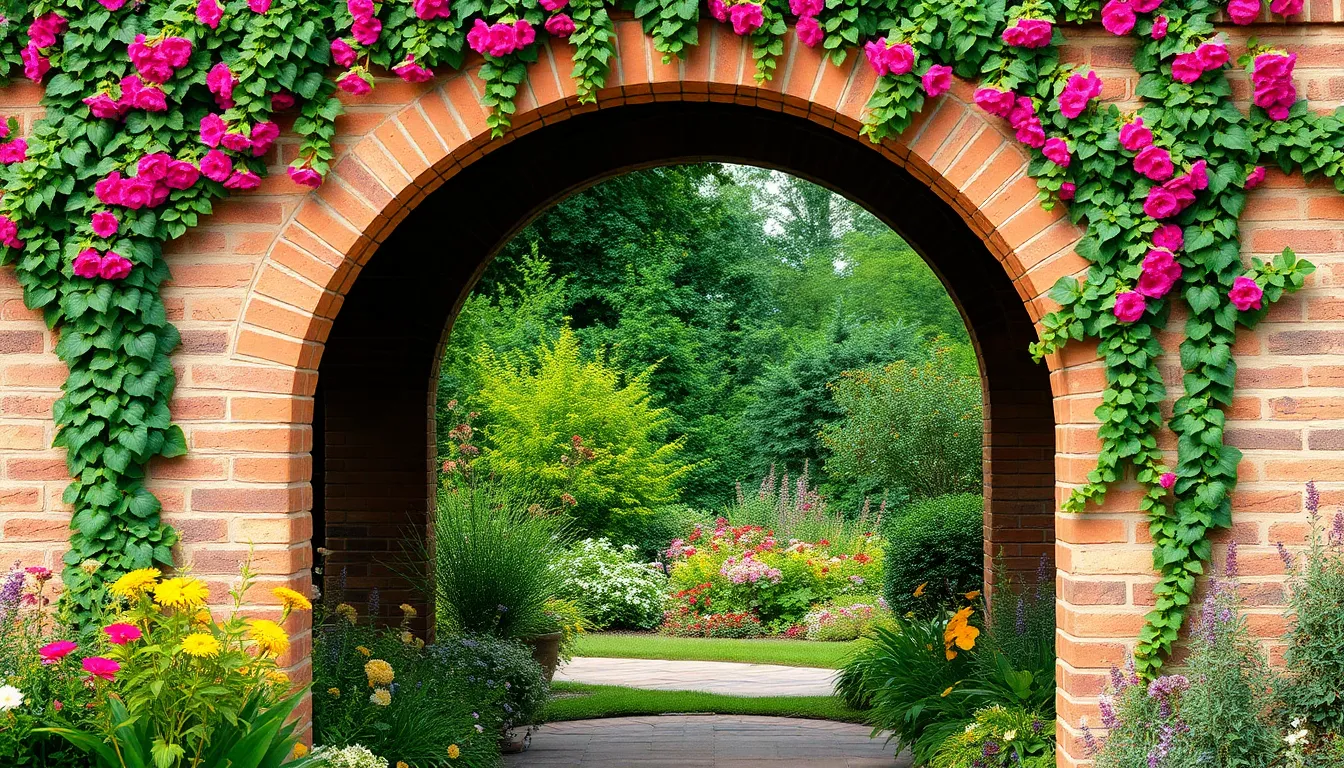
Creating substantial garden features with bricks establishes dramatic architectural elements that transform ordinary outdoor spaces into extraordinary garden sanctuaries. These permanent structures serve as stunning centerpieces while providing practical benefits for years to come.
Brick Garden Arches and Pergola Bases
Building brick arches at garden entrances creates dramatic architectural statements that welcome visitors with timeless elegance. These impressive structures provide natural shade while serving as stunning focal points that define garden boundaries and transitions between different outdoor areas.
Designing pergola bases with brick construction ensures sturdy foundations that support climbing vines and flowering plants beautifully. We recommend incorporating climbing plants like wisteria or jasmine around these structures to achieve a romantic and enchanted garden atmosphere that evolves throughout the seasons.
Constructing brick pergola bases requires careful attention to proper footing and drainage to prevent settling over time. The natural durability of brick materials withstands weather extremes while maintaining their structural integrity and visual appeal for decades.
Installing these architectural features involves creating level foundations and ensuring proper mortar joints for long-lasting stability. Professional installation techniques guarantee that your brick arches and pergola bases will remain beautiful focal points that enhance your garden’s overall design aesthetic.
Decorative Brick Columns
Designing brick columns adds vertical interest and classic elegance to garden landscapes while supporting various architectural elements. These structural features can range from simple geometric designs to ornate decorative patterns that complement your garden’s existing style and theme.
Creating column designs offers flexibility in height, width, and decorative elements to match your exact garden requirements. We suggest incorporating columns as standalone features or as supports for arches, pergolas, and other garden structures that require additional stability.
Building decorative brick columns requires precise construction techniques to ensure proper alignment and structural soundness. The versatility of brick materials allows for various finishing options, from smooth mortar joints to textured surfaces that add visual depth and character.
Positioning these columns strategically throughout your garden creates rhythm and flow while establishing clear sight lines and focal points. Consider placing columns at garden entrances, along pathways, or as anchoring elements for seating areas and outdoor dining spaces.
Brick Garden Sculptures and Art
Crafting unique sculptures with bricks transforms ordinary building materials into extraordinary artistic expressions that reflect your personal creativity. These three-dimensional art pieces can take various forms, from geometric patterns to brick-built animal figures that add whimsical touches to garden spaces.
Creating artistic brick installations allows for unlimited creative possibilities while maintaining the durability and weather resistance that bricks naturally provide. We encourage experimenting with different stacking patterns, mortar applications, and color combinations to achieve distinctive sculptural effects.
Building brick art pieces requires planning the design carefully to ensure structural stability while achieving your desired aesthetic outcome. Consider incorporating lighting elements or surrounding plantings that enhance the sculpture’s visual impact during different times of day and seasons.
Integrating these artistic elements strategically throughout your garden creates conversation pieces that surprise and delight visitors while showcasing your creative vision. Position sculptures as terminating vistas, nestled among plantings, or as central features in dedicated garden rooms for maximum visual impact.
Use Reclaimed and Recycled Bricks Creatively
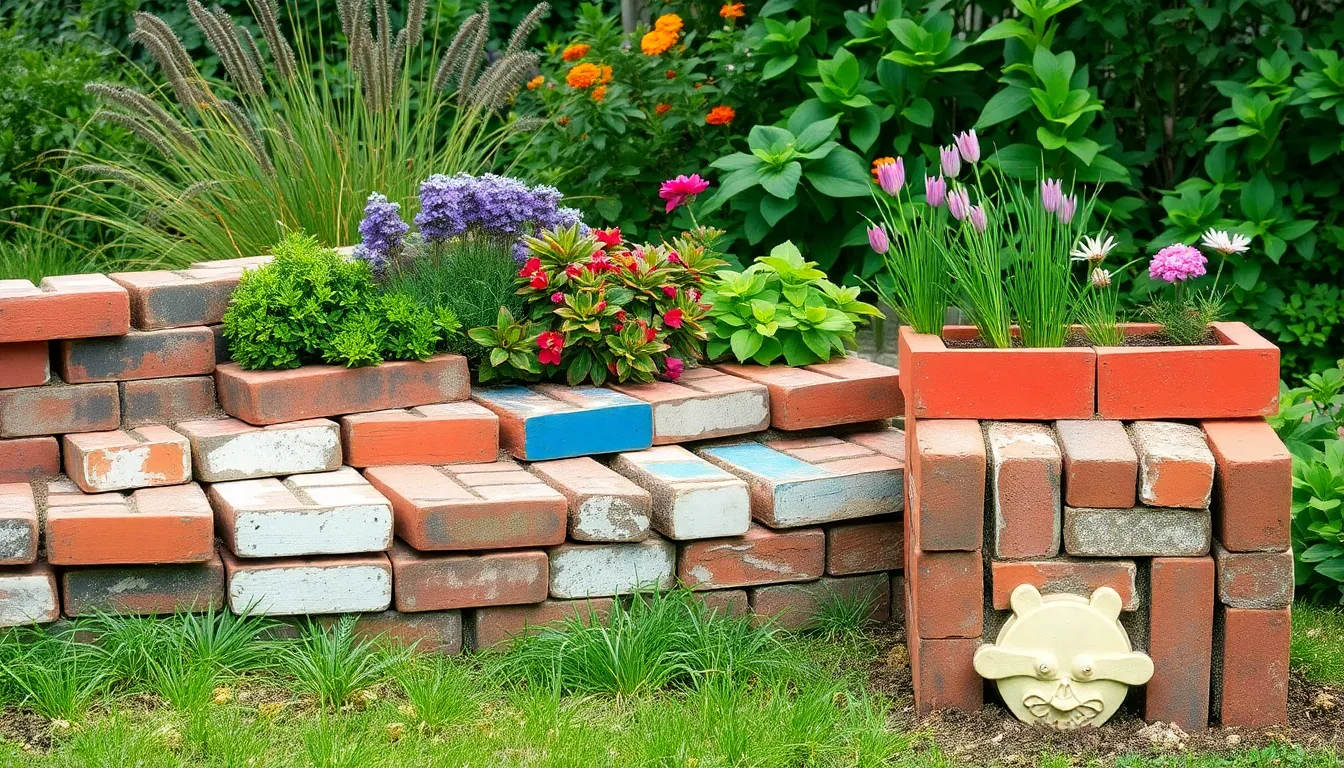
Moving beyond new materials opens countless possibilities for sustainable garden design. We’ll explore how reclaimed and recycled bricks bring unique character while reducing environmental impact.
Weathered Brick for Rustic Appeal
Weathered bricks deliver an instantly aged appearance that seamlessly blends with natural garden environments. Their time-worn surfaces create texture and visual depth that new bricks simply can’t match, making them perfect for low garden walls that define planting areas without overwhelming delicate plantings.
We’ve found these naturally distressed materials excel at constructing garden borders that separate different zones while maintaining organic flow throughout the industry. Moss and lichen often cling to weathered surfaces, improving the rustic aesthetic and creating living walls that evolve with each season.
Garden retaining walls built with weathered bricks provide structural support while appearing as though they’ve stood for decades. Their naturally varied colors complement both cottage garden styles and modern naturalistic designs, offering versatility that synthetic materials can’t provide.
Painted Brick Garden Accents
Painted bricks transform ordinary reclaimed materials into vibrant garden features that reflect personal style preferences. We can customize colors to match existing garden elements, creating cohesive designs that tie together pathways, planters, and architectural features.
Decorative garden borders benefit tremendously from painted brick treatments, especially when we want to add pops of color to neutral landscapes. Bold blues complement silver foliage plants, while warm terracotta tones enhance Mediterranean themed gardens and drought tolerant plantings.
Brick planters painted in coordinating colors create stunning focal points that draw attention to prized specimens or seasonal displays. Weather resistant exterior paints ensure these colorful accents maintain their vibrancy through multiple growing seasons, making them practical long term investments.
Mixed Vintage Brick Combinations
Mixed vintage brick combinations create distinctive garden features that tell stories through varied textures, colors, and historical origins. We can blend different brick types to achieve unique patterns that showcase craftsmanship while adding visual interest to garden walls and pathways.
Combining red clay bricks with cream colored varieties creates striking checkerboard patterns that work beautifully in formal garden settings. Fire bricks mixed with standard building bricks add warm orange tones that complement autumn plantings and create year round seasonal interest.
Planters constructed with mixed vintage bricks become artistic statements that serve functional purposes while displaying our commitment to sustainable materials. Each brick contributes its own character, resulting in one of a kind garden features that can’t be replicated with uniform materials.
Maintain and Care for Brick Garden Features
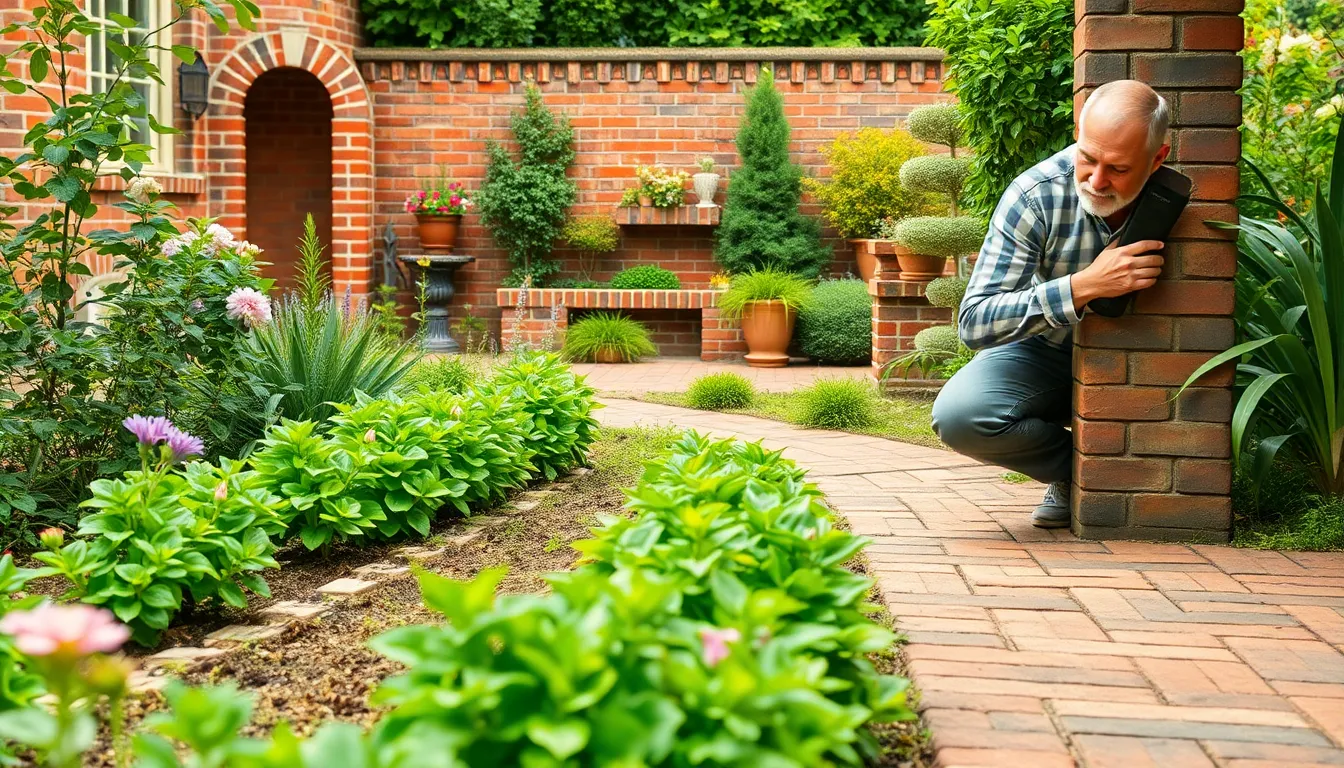
Proper maintenance ensures your brick garden features remain beautiful and structurally sound for years. Regular care prevents costly repairs and preserves the investment you’ve made in your outdoor space.
Cleaning Brick Garden Elements
Regular cleaning keeps brick surfaces looking their best while preventing permanent staining and deterioration. We recommend using mild detergent mixed with water for routine cleaning, as this gentle approach removes dirt and grime without damaging the brick’s surface.
Avoid harsh chemicals that can erode mortar joints and damage brick faces over time. Power washing on low settings works effectively for stubborn stains, but we suggest keeping the pressure below 1,500 PSI to prevent mortar erosion.
Seasonal deep cleaning should focus on removing moss, algae, and organic buildup that accumulates in damp areas. Mix one part white vinegar with three parts water to create an eco friendly solution that naturally breaks down organic growth without harming surrounding plants.
Repairing Mortar and Loose Bricks
Inspect mortar joints annually for cracks, gaps, or crumbling sections that compromise structural integrity. We find that early detection of mortar issues prevents more extensive repairs later, saving both time and money.
Repoint damaged mortar by removing loose material to a depth of at least half an inch before applying fresh mortar mix. Standard mortar consists of one part Portland cement, three parts sand, and enough water to achieve workable consistency.
Replace loose bricks immediately to prevent water infiltration and further damage to surrounding areas. Remove the damaged brick carefully, clean the cavity thoroughly, and set the replacement brick with fresh mortar on all sides for secure installation.
Match existing mortar color by adding concrete dye or using lime based mortar for older brick structures that require historically appropriate materials.
Seasonal Brick Garden Maintenance
Spring inspections should focus on winter damage assessment, checking for frost heaved bricks, cracked mortar, and vegetation overgrowth that may have occurred during dormant months.
Trim vegetation regularly around brick features to prevent root systems from compromising structural stability. We recommend maintaining at least six inches of clearance between plants and brick walls to allow proper air circulation.
Fall preparation includes removing debris from drainage areas around brick features and applying masonry sealer every three to five years to protect against freeze thaw cycles.
Monitor drainage throughout the growing season, ensuring water flows away from brick structures to prevent hydrostatic pressure buildup that can cause shifting or cracking.
Document maintenance activities with photos and notes to track the condition of your brick features over time, helping identify patterns that may require professional attention.
Conclusion
Brick garden features offer an unmatched combination of durability and timeless beauty that can transform any outdoor space. Whether you’re creating pathways that guide visitors through your garden or building raised beds that showcase your favorite plants we’ve shown you how versatile this classic material can be.
From functional elements like retaining walls and fire pits to decorative touches using reclaimed bricks each project adds character and value to your property. The key to success lies in proper planning installation techniques and regular maintenance to keep your brick features looking their best.
We encourage you to start with one project that excites you most and gradually expand your brick garden elements over time. With these ideas and techniques you’re well-equipped to create an outdoor space that you’ll enjoy for years to come.
Frequently Asked Questions
What are the main benefits of using bricks in garden design?
Bricks offer exceptional durability, withstanding weather conditions for decades. They provide versatility in design, suitable for pathways, planters, walls, and seating areas. Bricks help regulate soil temperature and moisture in raised beds, ensuring healthy plant growth. They also add timeless aesthetic appeal and can be sourced as reclaimed materials for sustainable gardening projects.
How do I create a herringbone brick pathway?
Start by excavating the area and laying a solid foundation with sand or gravel. Install edge restraints to keep bricks in place. Lay bricks in alternating 90-degree angles to create the zigzag herringbone pattern. Use a rubber mallet to level bricks and fill joints with sand. Compact the surface for stability.
What’s the difference between straight and curved brick borders?
Straight brick borders offer a formal, classic appearance with clean lines that clearly separate lawn from garden beds. Curved brick edging provides a softer, more naturalistic look that complements organic garden designs. Curved borders require more planning and cutting but create flowing, flexible boundaries that enhance landscape movement.
How do raised brick garden beds improve plant growth?
Raised brick beds provide excellent drainage, preventing waterlogged soil that can damage plant roots. The brick walls regulate soil temperature, keeping roots warmer in winter and cooler in summer. They also allow better soil control, enabling gardeners to create optimal growing conditions and reduce weeding and maintenance tasks.
What should I consider when building brick retaining walls?
Ensure proper foundation depth and drainage behind the wall to prevent water pressure buildup. Use appropriate mortar for your climate and install weep holes for water drainage. Consider the wall height and local building codes. For walls over 3 feet, consult a structural engineer to ensure safety and stability.
How do I maintain brick garden features?
Clean regularly with mild detergent and water, avoiding harsh chemicals that can damage mortar. Inspect mortar joints annually and repoint as needed to prevent water infiltration. Remove organic growth like moss or algae promptly. Check for loose bricks after freeze-thaw cycles and replace damaged materials immediately to prevent further deterioration.
Can I use reclaimed bricks for garden projects?
Yes, reclaimed bricks add unique character and are environmentally sustainable. Weathered bricks provide rustic charm perfect for informal gardens. Clean reclaimed bricks thoroughly and check for structural integrity. Mixed vintage bricks create distinctive patterns and textures, though you may need to sort by size and condition for consistent installation.
What’s the best pattern for brick fire pit areas?
Circular patterns work well for fire pits, creating intimate gathering spaces. Use fire-resistant bricks and proper mortar rated for high temperatures. Install a gravel base for drainage and maintain proper clearance from combustible materials. Consider local fire regulations and permits before construction, and always prioritize safety in design and placement.

